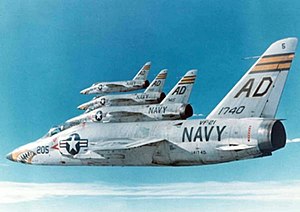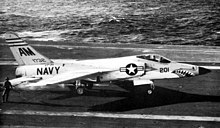| F11F/F-11 Tiger | |
|---|---|
| VF-21 F11F-1 Tigers in left echelon formation. | |
| Role | Fighter aircraft |
| Manufacturer | Grumman |
| First flight | 30 July 1954 |
| Introduced | 1956 |
| Retired | 1961 (Carrier) 1967 (Training) 1969 (Blue Angels) |
| Status | Phased out of service |
| Primary user | United States Navy |
| Produced | 1954-1959 |
| Number built | 200 |
The F11F/F-11 was used by the Blue Angels flight team from 1957 to 1969. Grumman Aircraft Corporation made about 200 Tigers, with last delivered 23 January 1959.
Contents
|
Design and development
The F11F (F-11) Tiger origins can be traced back to a privately funded 1952 Grumman concept to modernize the F9F-6/7 Cougar by implementing the area rule and other advances. This Grumman company project was known as the G-98, and by the end had departed totally from the Cougar.
Team photo of the Blue Angels F11F-1 c. 1958
The Navy Bureau of Aeronautics was sufficiently impressed to order two prototypes, designated XF9F-8 even though the new fighter was clearly a new design. To add to the confusion, the prototypes were then redesignated XF9F-9 with the XF9F-8 designation going to another more straightforward Cougar derivative. Since the afterburning version of the J65 was not ready, the first prototype flew on 30 July 1954 with a non-afterburning engine. In spite of this, the aircraft nearly reached Mach 1 in its maiden flight. The second prototype, equipped with the afterburning engine, became the second supersonic US Navy aircraft, the first being the Douglas F4D Skyray. In April 1955, the aircraft received the new designation F11F-1 (F-11A after adoption of the unified Tri-Service naming system in 1962). Carrier trials started on 4 April 1956 when an F11F-1 Tiger landed on and launched from USS Forrestal.[2]
The F-11 Tiger is noted for being the first jet aircraft to shoot itself down. On 21 September 1956, during a test firing of its 20 mm (.79 in) cannons, pilot Tom Attridge fired two bursts mid-way through a shallow dive. As the velocity and trajectory of the cannon rounds decayed, they ultimately crossed paths with the Tiger as it continued its descent, disabling it and forcing Attridge to crash land the aircraft; he survived.[3][4]
F11F-1F Super Tiger
In addition to the F-11A (F11F-1) fighter, Grumman also proposed a more advanced version of the airframe known as the F11F-1F Super Tiger. This was the result of a 1955 study to fit the new General Electric J79 engine into the F-11 airframe. The Navy was sufficiently interested to authorize modification of two production F11F-1s with enlarged air intakes and YJ79-GE-3 turbojets, with the result being designated the F11F-1F, indicating a production F11F-1 with a special engine fit. The aircraft first flew on 25 May 1956, reaching Mach 1.44 in one of the flights. After addition of 60° wing root fillets, a 13.5 in (35 cm) fuselage extension, and an uprated J79 engine, F11F-1F reached an impressive Mach 2.04 and an altitude of 80,250 ft (24,466 m). However, the U.S. Navy did not order it into production. Failing to secure the Navy contract, Grumman marketed the Super Tiger to foreign customers. The Super Tiger outperformed the Saab Draken, Lockheed F-104 Starfighter, Dassault Mirage III and Fiat G.91 in a tender to equip the Swiss Air Force; the Mirage III was finally chosen as a cheaper and more secure alternative, yet a close second performance wise[5][6]. The German Luftwaffe, Japan Air Self Defense Force and Royal Canadian Air Force showed considerable interest but eventually the Lockheed F-104 Starfighter was chosen. This outcome, however, was marred by the Lockheed bribery scandals, in which huge sums were paid to influential politicians in those countries to ensure the adoption of the Starfighter.[7]Operational history
Seven U.S. Navy squadrons flew the F11F-1: VF-21 and VF-33 in the Atlantic Fleet and VA-156 (redesignated VF-111 in January 1959), VF-24 (redesignated VF-211 in March 1959), VF-51, VF-121, and VF-191 in the Pacific Fleet. In service, the Tiger operated from the carriers USS Ranger, Intrepid, Hancock, Bon Homme Richard, Forrestal, and Saratoga. The F11F's career only lasted four years because its performance was inferior to the Vought F-8 Crusader and the J65 engine proved unreliable. Also, the range and endurance of the Tiger was found to be inadequate. Thus, the Navy cancelled all orders for the F11F-1P reconnaissance version and only 199 F11F-1 (F-11A) fighters were built. The aircraft was withdrawn from carrier operations by 1961. It continued in service, however, in the training command in south Texas, Beeville and Kingsville, until the late 1960s. Students performed advanced jet training in the F-9 Cougar, and upon completing that syllabus, were given a brief taste of supersonic capability before transitioning to fleet fighters.[7]While the F-11's fighter career was short, the Blue Angels performed in these aircraft from 1957 until 1969, when the Tiger was replaced by the McDonnell Douglas F-4 Phantom II.
Variants
- YF9F-9
- Original designation.
- F11F-1
- Single-seat fighter version for the U.S. Navy, re-designated F-11A in 1962. 199 built and later production aircraft had a longer nose. One was used for static test and a further production of 231 aircraft cancelled.
- F11F-1P
- designation of a Navy photo reconnaissance version, 85 were cancelled.[7]
- F11F-1F Super Tiger
- F11F-1 fitted with the J79-GE-3A engine, two built.
- F11F-2
- Intended designation of the production F11F-1F.
Operators
- United States Navy
- VF-21 (redesignated VA-43, later VF-43), Atlantic Fleet
- VF-24 (redesignated VF-211 in March 1959), Pacific Fleet
- VF-33, Atlantic Fleet
- VF-51, Pacific Fleet
- VF-121, Pacific Fleet
- VA-156 (redesignated VF-111 in January 1959), Pacific Fleet
- VF-191, Pacific Fleet
- ATU-203 (redesignated VT-23)
- ATU-223 (redesignated VT-26)
- Blue Angels
Specifications (F11F-1/F-11A)
Data from Bowers 1990, p. 257.
General characteristics- Crew: 1
- Length: 46 ft 11 in (14.3 m)
- Wingspan: 31 ft 7.5 in (9.6 m)
- Height: 13 ft 3 in (4.0 m)
- Wing area: 250 ft² (23 m²)
- Empty weight: 13,810 lb (6,277 kg)
- Loaded weight: 21,035 lb (9,561 kg)
- Max takeoff weight: 23,459 lb (10,663 kg)
- Powerplant: 1× Wright J65-W-18 turbojet
- Dry thrust: 7,400 lbf (32.9 kN)
- Thrust with afterburner: 10,500 lbf (46.7 kN)
- Maximum speed: Mach 1.1 (727 mph, 1,170 km/h) at 35,000 ft (11,000 m)
- Cruise speed: 577 mph (929 km/h)
- Range: 1,275 mi (1,110 nmi, 2,050 km)
- Service ceiling: 49,000 ft (14,900 m)
- Rate of climb: 16,300 ft/min (83 m/s)
- Wing loading: 84 lb/ft² (411 kg/m²)
- Thrust/weight: 0.50
- Guns: 4 × 20 mm (.79 in) Colt Mk 12 cannon, 125 rounds per gun
- Hardpoints: 4 with a capacity of - and provisions to carry combinations of:
- Rockets: Aero 6A or Aero 7A "Rocket Package"
- Missiles: AIM-9 Sidewinder
- Other: 150 gal drop tank







No comments:
Post a Comment